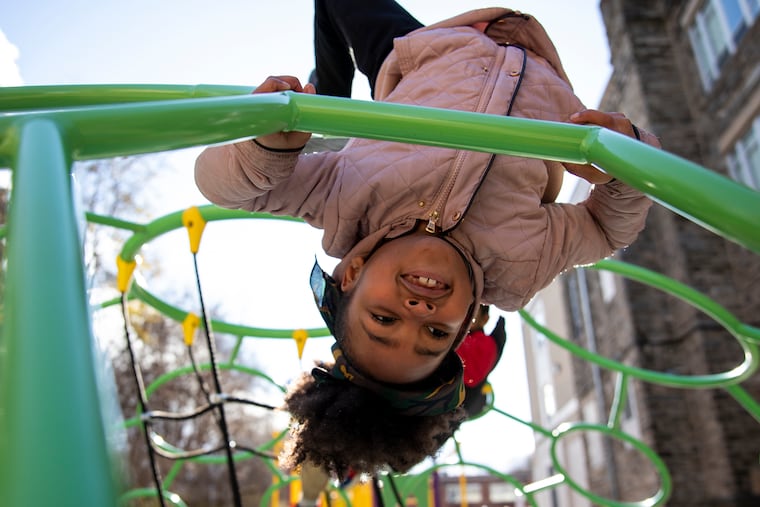At a Philly public school, blind children finally have a fantastic place to play
“When it opened, they just ran. This just takes away barriers of exclusion. It’s inclusive, and that’s so great.”

For a long time, it was a dream that seemed like it might never come true.
Overbrook Education Center, the Philadelphia School District’s school for blind and visually impaired children, had many things other schools would envy: small classes, engaged families, extracurricular activities, talented students who often go on to have their pick of the city’s select high schools.
But it lacked a safe place for its nearly 300 students to play.
When the weather was good, teachers could cross two streets to take students to a nearby city park, but it took considerable time and staffing to safely shepherd students there and back. Too often, the kids had to make do with a narrow strip of cracked asphalt.
So from the moment Meredith Foote became OEC’s principal five years ago, she told anyone who would listen: Our school needs its own playground. Then she heard that the Fund for the School District of Philadelphia, the district’s charitable arm, had launched a crowdfunding campaign in which principals could create wish lists for their schools, which individual donors and foundations could then browse and potentially fulfill.
So Foote aimed high in a way her operating budget did not allow her to.
It took five years, but Foote’s wish was finally granted: a $150,000 “sensory playground,” paid for with a grant from the Hess Foundation and designed with input from parents and pupils. The OEC children christened it in late October.
Sturdy and colorful, the playground features not just typical equipment — a climbing dome, a slide — but also pieces that allow students to explore using other senses. There are chimes, animal sounds, and textured pieces that students can explore with their hands. There are tables and chairs off to one side, places for students to sit and socialize, or to reset if they’re feeling overwhelmed.
“The playground has revolutionized things. Having a safe place for kids to play is such a blessing," said Foote, whose school is comprised of one-third visually impaired students from around the city and two-thirds students without visual challenges, chosen by lottery.
Byerrah Holden, 10, just figured her school would never have its own playground. She was used to sporadic trips to the city park, but those didn’t happen often enough for kids, she said.
When she finally saw a play space just for OEC students, on the school’s grounds, the fourth grader was “in shock.”
“We were all amazed,” Byerrah said. “We just love it!"
Her favorite part is the slide, but Byerrah also likes the blue-and-green egg-shaped piece of equipment that you can sit in and spin around.
First grader Khaliq Long hasn’t used the playground for long, but he’s had enough time to assess it, he said.
“Overall, I like it’s funness and all the things you can imagine to do,” said Khaliq, 6.
The playground has earned rave reviews from parents, too.
» READ MORE: Philly's new toy library saves money — and the environment — and grows community
Anton Austin, whose daughter Asha is a seventh grader at OEC, was on the committee that helped create the playground’s design.
“A lot of what makes this really special happened before a shovel even hit the ground,” said Austin. “There was so much forethought that went into making a playground that all of our students could experience and engage with."
Austin’s contribution to the project was emphasizing how durable the equipment needed to be. With no fence around the school’s space, when classes aren’t in session, the playground is bound to be used by neighborhood children.
“It’s going to get a workout on the weekends,” said Austin.
Rachel Fennell, mom of N’Rae Fennell, a sixth grader, and N’yla Fennell, who’s in third grade, is delighted that both her girls — one of whom is a regular education student and the other who has a visual impairment and other special needs — have a play space that suits both of them.
“They were the first two on the playground,” Fennell said. “When it opened, they just ran. This just takes away barriers of exclusion. It’s inclusive, and that’s so great.”